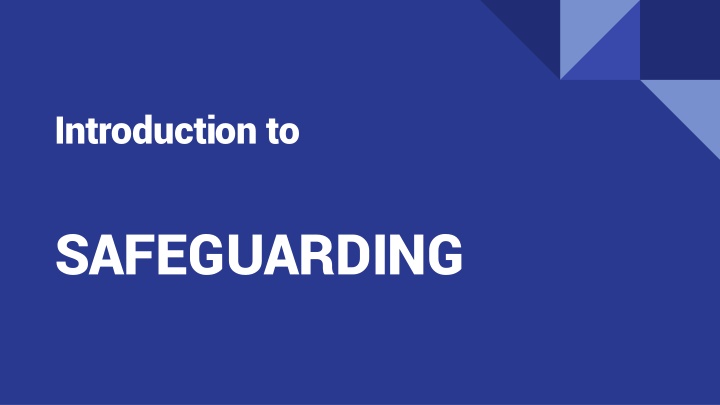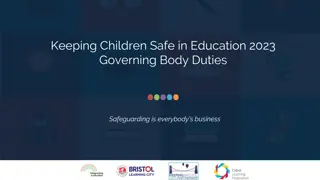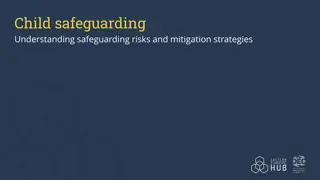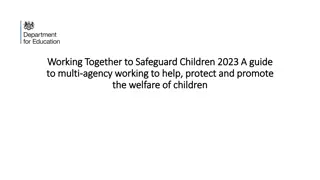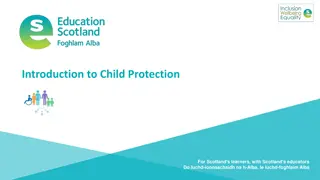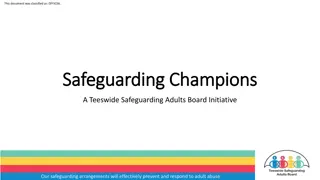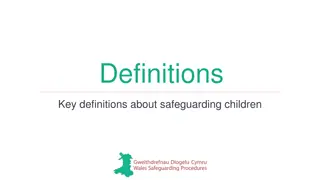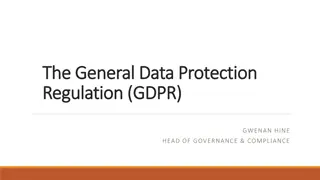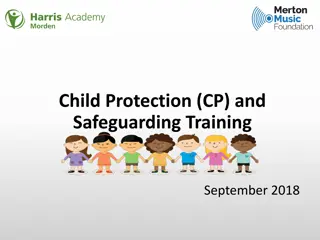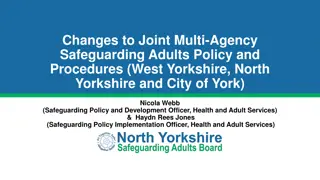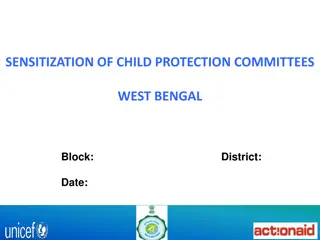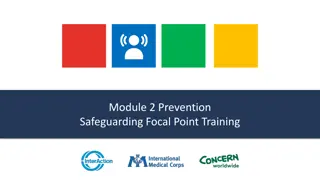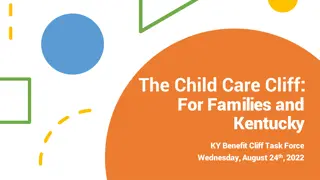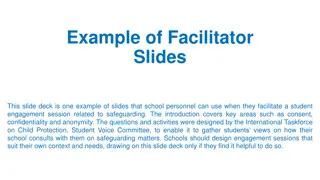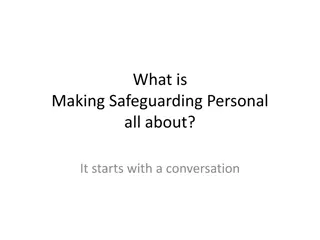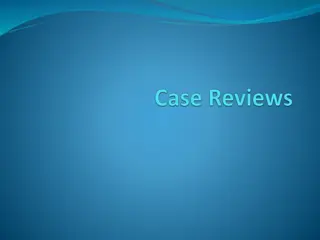Introduction to Safeguarding: Understanding Child Protection
Safeguarding encompasses protecting children and vulnerable adults from harm and abuse. It involves recognizing signs of neglect and abuse, reporting concerns, and following laws and guidelines. Learn about what safeguarding entails, who is considered a child, child protection processes, and the importance of safeguarding training. Discover common myths and truths about safeguarding children and understand roles and responsibilities in safeguarding practices.
Uploaded on Sep 30, 2024 | 0 Views
Download Presentation

Please find below an Image/Link to download the presentation.
The content on the website is provided AS IS for your information and personal use only. It may not be sold, licensed, or shared on other websites without obtaining consent from the author.If you encounter any issues during the download, it is possible that the publisher has removed the file from their server.
You are allowed to download the files provided on this website for personal or commercial use, subject to the condition that they are used lawfully. All files are the property of their respective owners.
The content on the website is provided AS IS for your information and personal use only. It may not be sold, licensed, or shared on other websites without obtaining consent from the author.
E N D
Presentation Transcript
Introduction to SAFEGUARDING
Topics to be Cover in this module What is Safeguarding Who is a Child What is Child Protection Who Commits Maltreatment Why is Safeguarding Training Important Myths and Truths about Safeguarding Children Roles and Responsibilities
What is Safeguarding? Safeguarding is an encompassing term describing all aspects of what it takes to ensure that the welfare of children and vulnerable adults are protected from harm and abuse acts such as : Neglect Physical, emotional, and sexual abuse Fraud and financial abuse Most people would consider this issue to be something more common amongst vulnerable and elderly adults although it can influence children as well. Think about children who work, e.g. as models or in the entertainment industry or children who have inherited money that either parents or guardians do not have.
What is Safeguarding ? The term Safeguarding describes the steps and considerations that authorities and many public services must take to either promote the welfare of the children / vulnerable adults to protect them from harm or abuse. It essentially educates and guides people from all walks of life into paying attention to the signs of neglect and abuse. What to look out for and how to report concerns, even if you are worried they may be wrong. It is better to be safe than sorry. There are many Laws, Guidelines, Policies and Frameworks in place. They help everybody involved in Safeguarding Children understand what they are expected to do, and how they should go about meeting these expectations. We will learn more about these in this module.
You are a child up until your 18th Birthday. Who is a Child This means that when we refer to Children or A Child we also mean children and young people. Most people understand who a child is, but in legal terms and for Safeguarding reasons there are specific definitions, usually by age.
What is a child It may feel cold, but Child Protection is a process. It s a process in place to ensure that children who are suffering from harm and abuse and neglect are protected. There are a lot of grey areas and uncertain terrain when it comes to assessing a child who needs protection and then protecting them. Sometimes it s difficult to see the signs and many abusers can seem to be incredibly kind and sincere. For people who have never experienced the kind of troubles that children in this situation do, it can be very difficult to determine whether they are hurting a child further by reporting their concerns as they may have not met the people who have been reported to harm the child.
What is Child protection The issues highlighted on the earlier slides is why we need processes like child protection in place. Support both the child and provide a process for reporting concerns. Ensure that authorities take the correct action which meets with the child s needs. Ensure that no stone is left unturned. The consequences of overlooking abuse and neglect are tragic, as you will come to see, as we cannot afford to take a risk on a child s life, which is why Child protection is necessary.
Who commits Maltreatment You may be surprised who may commit Maltreatment A parent A step parent A friends parent A neighbour A relative A colleague A friendly person down the road who may seem kind and charismatic A teacher A careworker A friend A doctor A shopkeeper It can be anybody.
Why is Safeguarding Training Important ? Safeguarding Training raises awareness, understanding and increases our knowledge about Safeguarding. It is a form of Child Protection which in many cases, is the first line of defence against Child Protect. Safeguarding Training ensures : Services surrounding children, promote more effective and integrated services that ensures they can approach Safeguarding issues appropriately, without overlooking a child in need. It will provide confidence and clarity for your own role concerning your Safeguarding duties. To provide overall, a better understanding of your role who works within Safeguarding.
Myths and Truths There are many Myths and Truths about Safeguarding, some of which we will cover here, others you will discover further along the course and more wil show up in your career. A list of Myths and Truths about Safeguarding will be shown, but please remember to keep an open mind around children and when you are performing your Safeguarding duties. Her are a few common Myths about Safeguarding. Myth 1. Women do not harm, neglect or sexually abuse children. The Reality Women are more likely to neglect, harm or emotionally abuse their children than sexually abuse them,. However, they are frequently an accomplice for sexual abuse, and around 5-10% of women, are sexual abusers.
Myths and Truths about Safeguarding Children Myth 2. It is usually strangers who abuse children. The Reality The majority of abusers or neglected children are abused or neglected by people they know and trust. Myth 3. There is usually only one abuser. The Reality There are actually many cases where children are abused at the hand of multiple people.
Myths and Truths about Safeguarding Children Myth 4. A kind well spoken person could not be an abuser. The Reality Many abusers, maybe not all, know exactly what to say and do, to get themselves out of trouble. It may be very hard for even a trained professional, to determine an abuser is speaking the truth or lying. Myth 5. Parents and families do not abuse children. The Reality Parents and families do harm their children.
Myths and Truths about Safeguarding Children Myths 6. Abuse doesn t happen in Care Homes or Hospitals. The Reality Abuse can happen anywhere, paedophiles especially often play the long game and will work in an establishment for an extended period before making their move on a child. Myth 7. It doesn t happen very often The Reality Child abuse, neglect and sex abuse is everywhere, and more prolific than you would imagine. Many cases go unreported, there are probably quite a few people in your circle or friends and family who have experienced abuse of some kind.
Myths and Truths about Safeguarding Children Myth 8. It doesn t happen here in our community/culture/family/country. The Reality Abuse happens in all classes, ethnic groups, cultures, communities. Myth 9. Children often lie. The Reality Children very rarely lie about abuse, they simply are scared more abuse will happen if the tell, and they often think no one will believe them. Myth 10 If a parent has an abused child they will lose custody of that child/children. The Reality Child protection services understand that the best place for the child is with the family and in some cases it is possible to keep the family together. In saome cases the child is not abused by the parents but if this is not the case they will be removed to keep them safe.
5 Facts About Safeguarding Children Most abusers are never convicted as children have such a hard time standing up against them in court. Some parents do not realise their child is being abused as it is their friend or relative who is the abuser.
5 Facts About Safeguarding Children Neglect is one of the hardest forms of abuse as the child development becomes severely impared. Peodaphiles spend years grooming a child. If you discover a child who is being abused, you will find it hard to file a report as you will question your judgement.
Agencies who must also adhere to Safeguarding requirements are:- Roles and Responsibilities Educational Services Housing authorities Local Authorities Social Services Everybody who works with children or who comes into contact with children has Safeguarding duties they must practice Psychologists Health Authorities Child protection Services
Roles and Responsibilities All of these services work with children and must know how to report their concerns. The reality is that Safeguarding Responsibilities belong to everyone. If you are not working with children but are concerned, you should report your concern to Child protection services who will have a duty to report it and follow it up.
Safeguarding Responsibilities Everybody has a responsibility to report their concerns about the wellbeing and safety of a child or young person. People who come into contact with a child has a responsibility to:- Be vigilant and look for signs of abuse and neglect. Report any concerns according to their organisations Safeguarding policies. General public may notice these signs at work and must report a concern. Report any concerns to the NSPCC or the Police if you feel the child is in danger.
SUMMERY Safeguarding children is a practice for protection. Child Protection is a process in place to make sure children at risk of harm, abuse and neglect are sufficiently protected. Anybody can commit maltreatment. Safeguarding training is crucial because it provides the confidence and clarity for the role concerning all safeguarding duties along with a better understanding of the role everybody plays in safeguarding children and it helps to promote effective and integrated services to ensure the safety of children.
Topics to be covered in this module 1. History of Child protection in the UK 2. The victoria Climbie Enquiry 3. Peter Connolly and Working Together 4. Child Protection System in England 5. The Child Act 6. Policy and Guidance 7. Other Legislation 8. Summery
History of Child Protection in the UK Surprisingly enough Child Protection as we know it now, was not always something we had access to. Back in the mid / late nineteenth century, there was no child protection in place. The only form of Child Protection came from the church or one or two kind people who happened to be there at the time.
History of Child protection in the UK Schooling was inadequate Child labour was common Child labour and neglect was accepted Child mortality was high Society never considered that children were abused It was not socially acceptable to inter To make matter worse
The beginning of Child Protection Legislation Surprisingly , the first changes concerning Child Protection was not concerning abuse it was simply focused instead on, Philanthropists focusing on reducing working hours for children in mines,factories and chimneys. 1. Social perception started to change as they realised it was not good for children to work in such bad conditions. 2. The first law was implemented to protect children from working in such harsh conditions.
The late Nineteenth Century to the Mid Twentieth Century There were two significant changes seen. 1. The formation of Child Protection Societies. 2. Societies perspective on Child Protection begune to change for the better. The case of Mary Ellen One case was of a girl of 10 years old from the USA, born 1864 who, after her fathers death, her mother was forced to adopt her, and she tragically neglected and abused by her carers.
The late Nineteenth Century To The Mid Twentieth Century Luckily, Mary Ellen s neighbours became aware of this and spoke out on her behalf, they made contact with a mission worker named Etta Wheeler and eventually made contact with a gentleman named Henry Bergh. Henry was the founder of the Prevention of Cruelty to Animals and began to help fight for Mary Ellen and he succeeded. A legislation was put in place and this became The Child Protection Society 1875. Thomas Agnew set up a Child Protection Society in the UK in 1883. In 1889 the Liverpool Society along with the London Society became the NSPCC.
From The Mid to the Late Nineteenth Century to Today In 1889, the UK Parliament saw the first Act which was to protect children. This condition of this legislation meant that by law, interventions were made between parents and their children and that anybody who mistreated a child could be arrested. There has now since been a steady progression of laws and legislations which have all been designed to protect the safety and well being of all children. As Child Protection and Child Abuse is such a complex matter, there are many legislations in place today.
From The Mid to Late Nineteenth Century to Today Most of the changes made in Child Protection today follow in the footsteps of the Mary Ellen case. These case which helped change legislations and policies,serve as examples of what can happen if something is not reported and nothing is done. This all goes to help authorities to amend their legislations to prevent similar cases in the future. To this day there will be cases that change the way we view and manage Child protection.
The Victoria Climbie Enquiry Victoria was an 8 years old girl and suffered hugely at the hands of her carers. During her 10 months in the UK she was :- Tied up in a black back in a bath in her own excrement. Burnt with cigarettes. Hit with bike chains, hammers and wire. Forced to eat cold food like a dog. Scalded
What went wrong ? Organisational failures Understaffed, undermanaged and dysfunctional social care department Lack of communication between departments and authorities Under resourced Constance absence of good practices Unclear responsibility at multiple levels There were 12 opportunities missed by the authorities. Some of Victorias case is described in the Laming Report 2003.
What went wrong Every Child Matter 2003 and The Children s Act 2004 follow the Laming Report to ensure all actions are taken to ensure all issues highlight in the Laming Report were corrected to ensure that the case of Victoria Climbie never happens again.
Peter Connelly and Working Together Another case followed soon after Victorias, in 2007. Another unfortunate child named Peter Connelly of 17 months died. Injuries he sustained were :- Broken Ribs. Broken back. Over 50 other injuries at the time of his sad death.
Peter Connelly and Working Together Peter s mother and her boyfriend and her boyfriends brother, were later convicted for their crimes in harming Peter. Some similarities to Victorias case were noticed such as :- Peter lived in the London borough of Haringey, the same borough as Victoria which meant, the same authorities had again failed the child and he slipped through the system. Peter was known to many other agencies and authorities and was even subject to a Child Protection Plan for physical abuse and neglect and also seen by community paediatrics for assessment but physical abuse and extensive injuries went undetected.
Peter Connelly and Working Together Following Peters death Lord Laming wrote a new report. This was called The Protection of Children in England: A Progress Report 2009 Previous previous recommendations were re-emphasised. This included : Multi agency working Collaboration up to government level Accountability and responsibility The importance of leadership The establishment of the National Safeguarding Delivery Unit 2009 Since Peters death a new guidance has been published : Working together to Safeguard Children 2010 and 2013.
The Child Protection System England In the UK , we have an organisation system for child protection, however each nation / county has its own responsibility. These can be checked on the NSPCC website. All principles are similar, laws are passed to prevent hard to children and guidelines are created to show agencies and organisations what is needed to maintain the safety of the child. Laws are passed to ward off abusers of harm by providing the actions that are required. The guidance sets out what agencies and organisations need to do in their part to keep children safe.
The Child Act The welfare of the child is paramount The Child Act, allocates duties and obligations to agencies,courts,authorities and parents concerning the Safeguarding and welfare of the child. Delay is likely to prejudice the welfare of the child The Child Act states that the child is better off with their parents and families. As long as parents cooperate with the legislation and compromise the care and wellbeing of the child. The court shall not make an order, unless to do so, would be better for the child than making no order ( the no order principle)
The Child Act 2004 After the death of little Victoria Climbie, The Child Act 1989 was revised. The new versions show in The Child Act 2004 and additions were added again in 2014. Such as: It made the change to appoint local authorities with their own Director of Children's Services. It created the post of Children s Commissioner for England. It has also placed a duty on the Local Authorities and their partners to co-operate in the well being of the child and making arrangements to safeguard and promote the children at all time.
Children and Social Work act 2017 The Children and Social Work Act 2017, follows a programme of suggested reforms of a policy paper which was called: Putting Children First, our vision for Children s Services. This policy focuses on the Safeguarding of all children who are already in the care system. It also covers new legislations relating to provisions of relationship and sex education.
Children and Social Work Act 2017 Relationships education will be provided to primary schools Child death review partners are required to review each death of a child in their area and identify matter which are relevant to children locally. The Child Safeguarding Practice Panel was established to review reports on serious child protection cases which may be complex or of national importance All local authorities must appoint personal advisers for children and young adults leaving care up to the age of 25yrs
Policy and Guidance Policies and Guidance set out how organisations and individuals should work together and include how partners should conduct the child s assessment. Working Together to Safeguard Children 2017 Under this guidance, The Department of Education highlight key statutory guidance for anyone working with children in England.
Policy and Guidance The main features are: Child death review partners are required to make provisions to review child deaths The Child Safeguarding Practice Review Panel is responsible for overseeing lessons learnt from serious child incidents and they also lie with the Safeguarding Partners at a local level Early years providers are required to have policies and procedures with Safeguarding Children in place Chief of Police, Local Authorities and clinical commissioning groups, replace Local Safeguarding Children s Boards and they must work together with relevant agencies to protect the welfare of children in their area
Keeping Children Safe in Education 2019 The Guidance sets out the legal duties of all staff in education must follow to Safeguard and promote the welfare of all children across the United Kingdom. The 5 parts are: 1. Ensure sufficient management of Safeguarding is in place 2. Provide all staff with Safeguarding information 3. Safer recruitment 4. What do if allegations of abuse occur against a member of staff 5. What they would do to manage child on child Sexual Violence and Sexual Harrassment
Keeping Children Safe in Education What To Do If You Are Worried a Child Being Abused : Advice for Practitioners These three steps should be followed:- Act immediately Follow your Child Protection Policy Speak to your manager or Designated Safeguarding Lead (DSL or Deputy ) as soon as possible
Keeping Children Safe in Education A DSL (Designated Safeguarding Lead) is the person appointed to take lead responsibilities and accountabilities for Child Protection issues in Schools and Colleges. The person holding this position must be a senior member of the School or Colleges leadership team and the role must be set out in the post holders job description. There must be a Deputy if the DSL is unavailable and should: Manage any support for the child internally using the schools pastoral support process Do an early help assessment Make a referral for statutory services
Keeping Children Safe in Education Things To Do if The DSL, Deputy is Not Available, if staff are not in a situation where they cannot reach the people they need to report to (DSL or Deputy) They should continue to take immediate action Speak to a member of the Senior Leadership Team (Senior Management) Contact the local Children s Social Care directly and follow their advice Report your actions to the DSL, via email , phone if not face to face, or deputy manager about any actions as soon as possible
Keeping Children Safe in Education If a child is in immediate danger or risk of harm, there are additional steps which should be followed. Staff should: Make a referral to Children s Social Care and the Police if appropriate, immediately Keep a log of all the concerns, discussions, decisions made, and the reasons for the decisions Discuss all of the actions made with the DSL or deputy as soon as possible Staff should also raise awareness immediately to the manager or DSL if there are concerns about a member of staff potentially abusing a child or young person There should be a whistleblowing hotline if you cannot get through to the DSL or deputy if this issue involves a member of staff.
Other Legislation The right to education The right to relax and play The right to be safe from violence The right to freedom of expression The United Nations Convention on The Rights of the Child 1989 This was created by Unicef and includes over 50 articles focusing on many aspects of a child life such as economic, social,civil,political, and cultural rights which a child is entitled to.
Every Child Matter 2003 This is a green paper outlining all of the proposal made by the Government of the reform and improvements of childcare. This followed Lord Laming s investigation following Victoria Climbie s death. The 5 principles which every child had the right to are : Be healthy Stay safe Enjoy and achieve Achieve economic well being Make a positive contribution Each principle has a detailed framework which every agency must follow.
Mental Capacity Act (MCA) 2005 MCA protect and empowers people who lack mental capacity. There are 5 fundamental principles that all agency workers must consider they are :- People must be support as much as possible to be able to make their own decisions before anyone else concludes that they cannot do so Every adult has the right to make their own decisions and the people around them must assume they have the capability to make some of their own decisions unless it is proven otherwise People have the right to make what they may think as unwise or eccentric decisions Anything for on behalf of people without capacity should be the least restrictive of their basic rights Any actions made for that person who lacks mental capacity must be in their best interests
